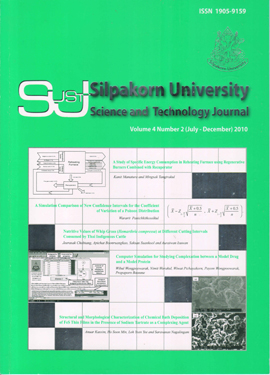Computer Simulation for Studying Complexation between a Model Drug and a Model Protein
Main Article Content
Abstract
Computer simulation is one of effective tools for instructors to illustrate complexation or bindinginteraction between a model drug and a model serum protein in its entire intricacy since the students can beeconomically exposed to a large variety of results of laboratory design within a relative short period of time.The program of computer simulation was created with Microsoft AccessTM. In this simulation program,theoretical parameters such as stoichiometric ratio and binding constants were assigned. After users definedinitial concentrations for drug and protein, the program would calculate free drug after complexation andadding noise with zero mean and standard deviation according to the user-defined relative standard deviation.The noise added would make the dataset to be more realistic. Users could use this obtained data to furthercreate a Scatchard plot. The fourth-year pharmaceutical care students of the Faculty of PharmaceuticalSciences, Prince of Songkla University used this program in studying “complexation” topic. Satisfaction ofthe students on the instruction using this computer simulation program was determined using a five-choicequestionnaire. The results indicated that this learning method was useful and satisfactory. Most responseson the satisfaction with the study via this simulation program were averagely rated above 3 from 5.
Downloads
Article Details
References
Daykin C. D., Pentikainen T., and Pesonen M. (1994). Practical Risk Theory for Actuaries, pp. 469. London: Chapman & Hall.
Hayton W. L. and Collins P. L. (1991). STELLA: Simulation software for pharmacokinetic software. American Journal of Pharmaceutical Education, 55: 131-134.
Martin A. (1993). Physical Pharmacy, 4th ed., pp. 251-283. Philadelphia: Lea & Febiger.
Mezei J., Kuttel S., and Rácz, I. (1990). Computerassisted instruction: how to solve drug formulation problems. American Journal of Pharmaceutical Education, 54: 30-34.
Nelson A. A. and Gagnon J. P. (1975). PHARMASIM: a computer simulation game of the pharmaceutical industry. Med Mark Media, 10: 54-60.
Ramanathan M., Chau R. I., and Straubinger R. M. (1997). Integration of Internet-based technologies as a learning tool in a pharmaceutical calculations course. American Journal of Pharmaceutical Education, 61: 141-148.
Wongpoowarak W, Wongpoowarak P, and Boonme P. (2008). Simulation tool for teaching multivariate experimental design on paracetamol syrup formulation. Silpakorn University Science and Technology Journal, 2(1): 45-52.
Wongpoowarak W. and Boonme P. (2005). Computer simulation for studying effects of laboratory design on results of accelerated stability test. Silpakorn University International Journal, 5(1-2): 108-117.


